
Eremophila divaricata, also known as spreading emu bush, is a flowering plant in the figwort family, Scrophulariaceae and is endemic to Australia. It is a shrub with stiff, spreading, tangled branches which are often spiny on their ends, erect leaves and mauve to lilac-coloured flowers.
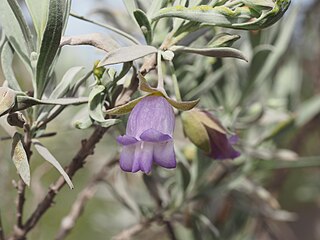
Eremophila maitlandii, commonly known as Shark Bay poverty bush, is a flowering plant in the figwort family, Scrophulariaceae and is endemic to Western Australia. It is a silvery-grey shrub with linear leaves and lilac-coloured to light purple flowers and is common in coastal areas between Shark Bay and Carnarvon.

Eremophila fraseri, commonly known as burra or jilarnu, is a flowering plant in the figwort family, Scrophulariaceae and is endemic to Western Australia. It is a shrub or small tree with all above-ground parts of the plant, apart from the petals, sticky and shiny due to the presence of a large amount of resin. The petals are coloured white, cream, pink and brown.

Eremophila mackinlayi, commonly known as desert pride, is a flowering plant in the figwort family, Scrophulariaceae and is endemic to Western Australia. It is a shrub with its branches and leaves covered with a thick layer of yellow to grey hairs, mostly egg-shaped leaves and deep lilac-coloured to purple flowers. It is most closely related to E. strongylophylla and E. hygrophana and sometimes occurs in the same areas as these species.

Eremophila hughesii is a flowering plant in the figwort family, Scrophulariaceae and is endemic to Australia. It is spindly, glabrous shrub with narrow leaves and with flowers that vary in colour from blue to pink, sometimes white. It is endemic to Western Australia and the Northern Territory.

Eremophila subfloccosa, also known as dense-felted eremophila is a plant in the figwort family, Scrophulariaceae and is endemic to Australia. It is a shrub which often has foliage covered with soft hairs, giving the plant a silvery grey hue and making it soft to touch. The leaves are strongly scented when crushed. Its flowers are usually greenish yellow in colour and have the stamens protruding from the ends. Dense-felted eremophila is common after fire, but becomes less so as others recover and compete with it.
Eremophila adenotricha, commonly known as glandular-haired eremophila, is a flowering plant in the figwort family, Scrophulariaceae and is endemic to a small area in the south-west of Western Australia. It is an erect shrub with sticky, aromatic leaves and pink, blue or purple flowers. It is a rarely seen shrub, apparently short-lived, mostly occurring in open, disturbed areas.
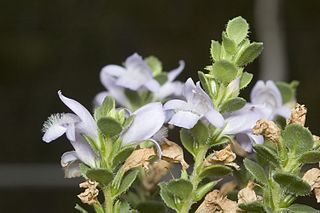
Eremophila behriana is a flowering plant in the figwort family, Scrophulariaceae and is endemic to South Australia. It was one of the plants collected on the 1858 - 1859 Babbage expedition to explore areas north of Adelaide and was later described by Ferdinand von Mueller. It is a small shrub, usually with egg-shaped, serrated leaves and lilac to purple flowers with hairs on the lower petal lobe.
Eremophila crassifolia, commonly known as thick-leaved emubush or trim emubush, is a flowering plant in the figwort family, Scrophulariaceae and is endemic to an area extending from New South Wales through Victoria to southern parts of South Australia. It is a low, spreading shrub with clustered leaves and bell-shaped, usually mauve-coloured flowers.

Eremophila densifolia is a flowering plant in the figwort family, Scrophulariaceae and is endemic to the south-west of Western Australia. It is usually a low, spreading shrub with densely clustered leaves and lilac to purple flowers.
Eremophila elderi, commonly known as aromatic emu bush, is a flowering plant in the figwort family, Scrophulariaceae. It is endemic to central Australia where it grows near the border between Western Australia, South Australia and the Northern Territory. It is an erect, aromatic shrub with sticky leaves and branches and usually pale coloured to white flowers. Its specific epithet (elderi) honours an early Australian businessman, Thomas Elder.
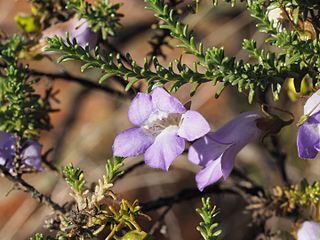
Eremophila exilifolia is a flowering plant in the figwort family, Scrophulariaceae, and is endemic to Western Australia. It is a widely distributed shrub which is shaped like an inverted cone and has small, very sticky leaves and branches and lilac-coloured flowers.

Eremophila pantonii, commonly known as broombush, is a flowering plant in the figwort family, Scrophulariaceae and is endemic to Western Australia. It is a broom-shaped shrub with narrow leaves which have a hooked tip, and blue or purple, sometimes white flowers in winter and spring.

Eremophila phillipsii is a flowering plant in the figwort family, Scrophulariaceae and is endemic to Western Australia. It is a tall, erect, open shrub, with narrow leaves and lilac to purple flowers which are white with purple spots inside. It often has an offensive smell.

Eremophila polyclada, commonly known as twiggy emu-bush, flowering lignum, lignum fuchsia and desert lignum is a plant in the figwort family Scrophulariaceae and is endemic to Australia. It is a dense, spreading shrub with narrow leaves and white to pale lilac-coloured, purple-spotted flowers. It occurs in all mainland states except Western Australia.
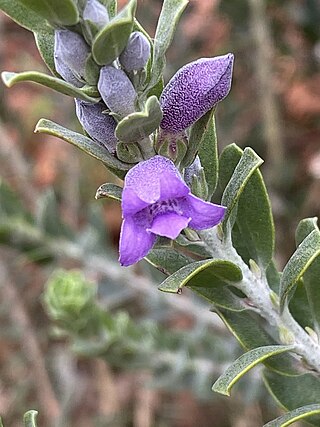
Eremophila resinosa, also known as resinous eremophila, is a flowering plant in the figwort family, Scrophulariaceae and is endemic to Western Australia. It is a spreading shrub with sticky young foliage, short leaves, small sepals and mauve, purple or sometimes white flowers.
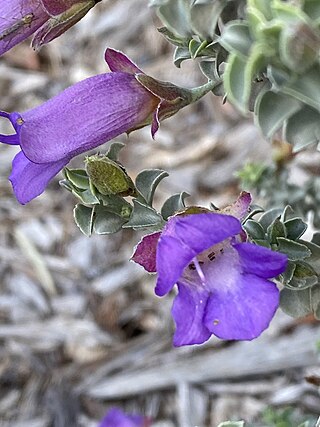
Eremophila rotundifolia is a flowering plant in the figwort family, Scrophulariaceae and is endemic to Australia. It is a shrub with many tangled branches with its leaves and branches covered with a layer of silvery-grey hairs. Its flowers range in colour from pale to deep lilac. It is common in South Australia and there is also a single record from the Northern Territory.
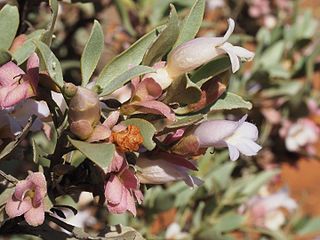
Eremophila tietkensii is a flowering plant in the figwort family, Scrophulariaceae and is endemic to Australia. It is a rounded to flat-topped shrub with grey-green leaves, usually pinkish-purple sepals and mauve, pink or lilac-coloured petals. It is mostly found in Western Australia but also occurs in the far west of the Northern Territory.

Eremophila willsii is a flowering plant in the figwort family, Scrophulariaceae and is endemic to Australia. It is an erect shrub with bright green, often serrated leaves and pinkish to deep pinkish-purple petals. It is mainly found in Western Australia, the Northern Territory and South Australia in deep sand.
Eremophila subangustifolia is a flowering plant in the figwort family, Scrophulariaceae and is endemic to the south-west of Western Australia. It is a highly branched shrub which produces a slightly unpleasant odour and has its younger parts densely covered with greyish hairs. The leaves are scattered along the branches and the mostly white flowers are borne singly in leaf axils. It only occurs in a small area near Eneabba and had previously been known as E. microtheca subsp. 'narrow leaves'.

















